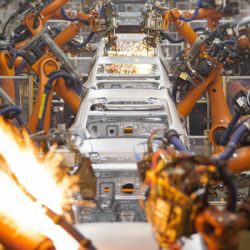US automotive sector and trade tariffs

The Ford Motor Company is an American-based automobile manufacturer and the “fifth most valuable” car brand worldwide. The company generated around 156.8 billion U.S. dollars in revenue in 2017, up from about 152 billion U.S. dollars in 2016. The company operates in North and South America, Europe, the Asia Pacific region, as well as Africa.
For Ford Motors, 2018 has not been a good year so far. US President Donald Trump’s erratic global trade policies, rising prices of raw materials (steel and aluminium) and unexpected moves in commodity markets by China are the primary causes to blame for this drag.
Starting from March, 2018, the US government gradually started levying import tariff on foreign steel and aluminium (25% and 10% respectively). This immediately altered the financial forecasts of the entire US automotive industry. Giving opinion on prices of steel and aluminium, Ford’s president of global markets, Jim Farley said “The escalation of steel and aluminium prices is really significant.” He also voiced the policy of the company that the increased costs (approximately $ 1.6 billion) will be absorbed by the company and will not be passed on to its customers. Ford Motors is not alone. The entire US automotive industry has felt the impact.
On 8 August, 2018, in a surprise move Chinese traders through Shanghai Futures Exchange accumulated “68,430 future contracts of aluminium for delivery in October”. This activity happened within 30 minutes of the opening of futures market. Ripple effects of these trades triggered “buy” orders in London Metal Exchange (LME). Aluminium rates for “three months delivery contracts” climbed 3.3% in a single day to settle at $ 2,016 metric ton at 5:50 p.m. (London time).
To understand the inexorable rise of steel and aluminium prices in the US market it is important to analyse production and trade statistics. After steel, aluminium is the “most widely used metal” in automotive industry.
In 2017, the United States of America imported US$23.4 billion worth of aluminium from a total 130 global trade partners. That dollar amount reflects a 49.3% increase since 2013 and an aggressive 24.9% uptick from 2016 to 2017.
The statistics clearly depict the fact that the US economy is significantly dependent on imports of steel and aluminium. The automative sector, being one of the largest consumers of Steel and Aluminium is worst hit by rising prices of these commodities.
What US aims to achieve by imposing tariffs?
US wants to increase its share in global production of steel and aluminium. President Trump’s move has angered US trade allies but he is adamant on pursuing his “Made in America Policy”.
What does it mean for US steel and aluminium producers?
In past, due to large imports of steel and aluminium, many US producers had abandoned their production lines. Gradually, those producers are now restarting their abandoned lines and some are even building new production lines. Some of the US producers that are leading the charge are; Alcoa, Century Aluminium and United Steels Corp.
Will this “Made in America Policy” of President Trump give respite to the automative industry?
In the short-term, the answer is no. US producers of Steel and Aluminium want to feel confident that the trade tariffs are here to stay for good and “no exemptions will be granted”. Once the US steel and aluminium producers are convinced, then they will invest in new production lines to gain their lost share of global production and realise profits on their investments. Until that time, the auto-sector of US will have to keep walking on tight rope.


